 | | | Switch to: Europe, USA, New Zealand, Antarctica Credit: NOAA/Ovation  Planetary K-index Planetary K-index
Now: Kp= 1.67 quiet
24-hr max: Kp= 3.00 quiet
explanation | more data
Interplanetary Mag. Field
Btotal: 7.79 nT
Bz: 5.59 nT north
more data: ACE, DSCOVR
Updated: Today at 1146 UT  Coronal Holes: 21 Mar 23 Coronal Holes: 21 Mar 23 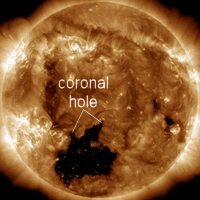
Solar wind flowing from this large southern coronal hole should reach Earth on March 24. Credit: SDO/AIA  Noctilucent Clouds Noctilucent Clouds
Bad news: NASA's AIM spacecraft, which monitors noctilucent clouds, may be dead due to problems with an onboard battery. Mission controllers have not yet given up all hope, so stay tuned. Switch view:Ross Ice Shelf, Antarctic Peninsula, East Antarctica, Polar Updated Mar21  SPACE WEATHER
NOAA Forecasts | | Updated at: 2023 Mar 21 2200 UTC FLARE | 0-24 hr | 24-48 hr | CLASS M | 20 % | 20 % | CLASS X | 01 % | 01 % |  Geomagnetic Storms: Geomagnetic Storms:
Probabilities for significant disturbances in Earth's magnetic field are given for three activity levels: active, minor storm, severe storm Updated at: 2023 Mar 21 2200 UTC Mid-latitudes | 0-24 hr | 24-48 hr | ACTIVE | 15 % | 30 % | MINOR | 01 % | 10 % | SEVERE | 01 % | 01 % | High latitudes | 0-24 hr | 24-48 hr | ACTIVE | 15 % | 15 % | MINOR | 20 % | 25 % | SEVERE | 20 % | 40 % | | | |  | | | | | | | | | | | Never miss another geomagnetic storm. Sign up for Space Weather Alerts and you'll receive a text message when magnetic storms erupt. Aurora tour guides and professional astronomers use this service. You can, too! | | | CLOSE ENCOUNTER WITH A CME: Even a near miss from a CME can spark beautiful auroras. Case in point: Yesterday, March 20th, the interplanetary magnetic field (IMF) near Earth suddenly rotated by almost 180 degrees. This kind of magnetic ripple is a typical sign of a CME passing nearby. The "ripple effect" ignited colorful lights inside the Arctic Circle. Aurora alerts: SMS Text. SUNRISES DON'T LOOK THE SAME ANYMORE: Solar Cycle 25 is changing the appearance of sunrises. It's making them spotted. David J. Kriegler sends this example from Gulf Shores, Alabama: 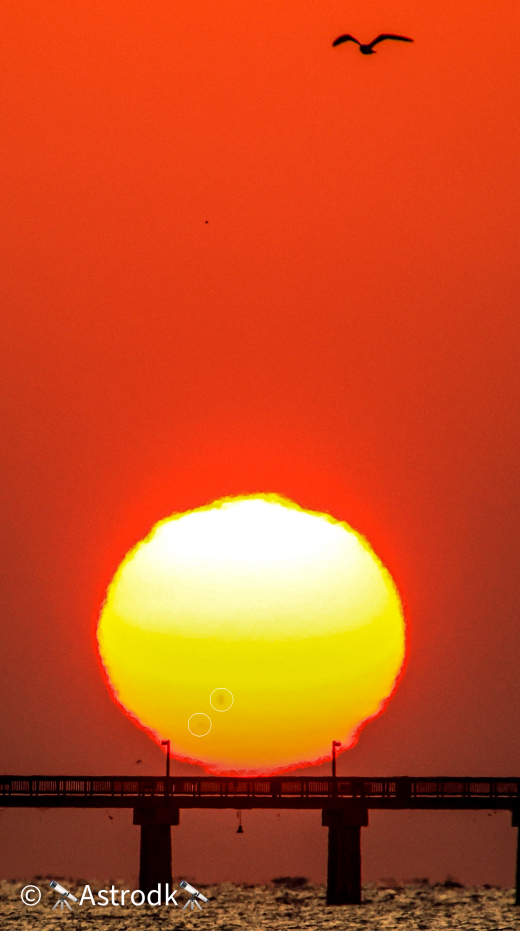
"This morning I photographed the sunrise from a pier overlooking the Gulf of Mexico," says Kriegler. "I could see sunspots AR3256 and AR3257 through the marine haze." Over the past two months, sunspot numbers have shot up to their highest values in nearly 10 years--a sign of the intensification of Solar Cycle 25. We're nowhere near the apex of the sunspot curve, however. Solar Max isn't expected until 2024 or 2025. This means sunrises (and sunsets) will become even more spotted in the years ahead. Aurora alerts: SMS Text. more images: from C.S. McKiness of Des Moines, IA Realtime Space Weather Photo Gallery
Free: Spaceweather.com Newsletter A LARGE HOLE IN THE SUN'S ATMOSPHERE: A large hole has opened in the sun's atmosphere, and it is spewing a stream of solar wind toward Earth. NASA's Solar Dynamics Observatory photographed the structure on March 20th: 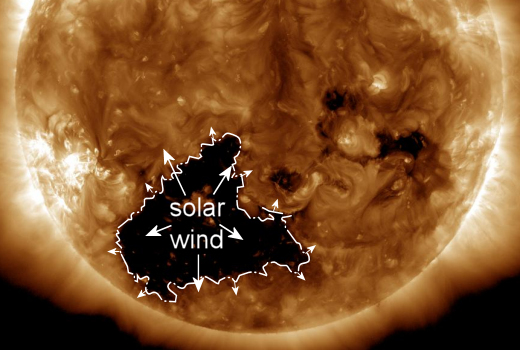
This is a "coronal hole" -- a region in the sun's atmosphere where magnetic fields open up and allow solar wind to escape. It looks dark in this ultraviolet image because glowing-hot gas normally contained there is missing. The solar wind will reach Earth on March 24, only a few days after the vernal equinox. This is perfect timing for aurora chasers. Because of the Russell-McPherron effect, even a slight gust of solar wind around the equinoxes can spark a good display of high-latitude auroras. Aurora alerts: SMS Text. Realtime Aurora Photo Gallery
Free: Spaceweather.com Newsletter RARE MR. SPOCK MUG: It's the logical way to wake up in the morning: Coffee in a rare Mr. Spock mug. This unique ceramic collector's item flew to the stratosphere onboard an Earth to Sky Calculus cosmic ray research balloon: 
You cannot buy these mugs anywhere on the internet--not even Amazon. But you can have one from Earth to Sky Calculus for $170.10. That's the serial number of the Enterprise divided by 10. The mug comes with a greeting card showing the item in flight and telling the story of its journey to the edge of space and back again. It's a great gift for any Trekkie! Far Out Gifts: Earth to Sky Store
All sales support hands-on STEM education
Realtime Aurora Photo Gallery
Free: Spaceweather.com Newsletter Every night, a network of NASA all-sky cameras scans the skies above the United States for meteoritic fireballs. Automated software maintained by NASA's Meteoroid Environment Office calculates their orbits, velocity, penetration depth in Earth's atmosphere and many other characteristics. Daily results are presented here on Spaceweather.com. On Mar 21 2023, the network reported 4 fireballs.
(4 sporadics) 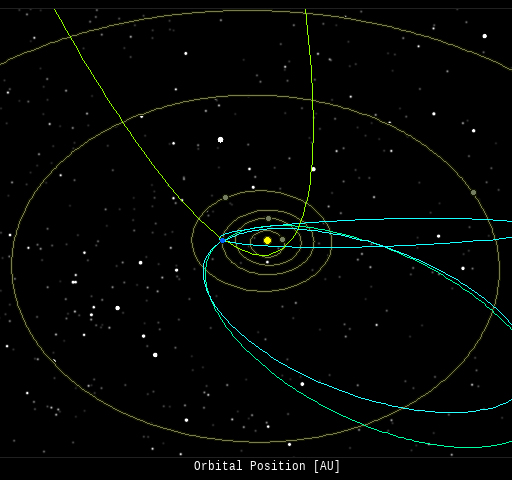 In this diagram of the inner solar system, all of the fireball orbits intersect at a single point--Earth. The orbits are color-coded by velocity, from slow (red) to fast (blue). [Larger image] [movies] Potentially Hazardous Asteroids ( PHAs) are space rocks larger than approximately 100m that can come closer to Earth than 0.05 AU. None of the known PHAs is on a collision course with our planet, although astronomers are finding new ones all the time. On March 21, 2023 there were 2329 potentially hazardous asteroids.
 | Recent & Upcoming Earth-asteroid encounters: | Asteroid | Date(UT) | Miss Distance | Velocity (km/s) | Diameter (m) | | 2023 FS | 2023-Mar-16 | 1.8 LD | 15.2 | 19 | | 2023 EY | 2023-Mar-17 | 0.6 LD | 8.1 | 15 | | 2018 UQ1 | 2023-Mar-17 | 10.7 LD | 11.7 | 143 | | 2023 ES1 | 2023-Mar-17 | 5.1 LD | 8 | 10 | | 2023 EZ | 2023-Mar-18 | 16.3 LD | 6.6 | 20 | | 2023 FO | 2023-Mar-19 | 0.9 LD | 6.2 | 5 | | 2016 WH | 2023-Mar-19 | 18.1 LD | 11.8 | 14 | | 2023 EV2 | 2023-Mar-20 | 4.6 LD | 13.2 | 21 | | 2023 FV1 | 2023-Mar-21 | 4.9 LD | 13.8 | 9 | | 2018 FE3 | 2023-Mar-21 | 10.1 LD | 5.4 | 13 | | 2023 FT | 2023-Mar-22 | 13.4 LD | 10.8 | 37 | | 2023 FG | 2023-Mar-23 | 1.8 LD | 10.8 | 11 | | 2023 FK1 | 2023-Mar-23 | 4.9 LD | 13.4 | 15 | | 2023 EO1 | 2023-Mar-23 | 6.8 LD | 21.1 | 45 | | 2023 EF2 | 2023-Mar-23 | 10 LD | 14.2 | 26 | | 2023 FA | 2023-Mar-23 | 3.1 LD | 8.7 | 18 | | 2023 DZ2 | 2023-Mar-25 | 0.5 LD | 7.8 | 55 | | 2023 FL2 | 2023-Mar-26 | 12.2 LD | 6.1 | 21 | | 2023 DX2 | 2023-Mar-27 | 8.5 LD | 9 | 54 | | 2019 FT | 2023-Mar-27 | 17.1 LD | 28.2 | 93 | | 2022 YK4 | 2023-Mar-29 | 11.9 LD | 2.3 | 25 | | 2023 FR1 | 2023-Mar-30 | 19 LD | 7.9 | 42 | | 2023 EK2 | 2023-Mar-30 | 12.9 LD | 15.4 | 88 | | 2017 SE12 | 2023-Mar-30 | 5.2 LD | 8.4 | 15 | | 2016 GH1 | 2023-Mar-30 | 7.7 LD | 5.8 | 11 | | 2022 GO3 | 2023-Apr-02 | 17 LD | 11.6 | 15 | | 2021 GN1 | 2023-Apr-02 | 17.7 LD | 14.2 | 18 | | 2023 FM | 2023-Apr-06 | 7.9 LD | 15.9 | 170 | | 2018 FD | 2023-Apr-07 | 17.9 LD | 8.2 | 47 | | 2023 FT1 | 2023-Apr-10 | 19.6 LD | 6.6 | 31 | | 2019 GK21 | 2023-Apr-13 | 15.2 LD | 8.1 | 27 | | 2022 YK9 | 2023-Apr-13 | 19.9 LD | 9.9 | 175 | | 436774 | 2023-Apr-13 | 12.5 LD | 17.6 | 719 | | 2006 HV5 | 2023-Apr-26 | 6.3 LD | 17.4 | 400 | | 2021 JF2 | 2023-Apr-28 | 16.6 LD | 8 | 19 | | 2018 VS6 | 2023-May-01 | 5.2 LD | 11.6 | 14 | | 2011 KY15 | 2023-May-18 | 19.9 LD | 14.3 | 54 | Notes: LD means "Lunar Distance." 1 LD = 384,401 km, the distance between Earth and the Moon. 1 LD also equals 0.00256 AU. | | Cosmic Rays in the Atmosphere | SPACE WEATHER BALLOON DATA: Almost once a week, Spaceweather.com and the students of Earth to Sky Calculus fly space weather balloons to the stratosphere over California. These balloons are equipped with sensors that detect secondary cosmic rays, a form of radiation from space that can penetrate all the way down to Earth's surface. Our monitoring program has been underway without interruption for 7 years, resulting in a unique dataset of in situ atmospheric measurements. Latest results (July 2022): Atmospheric radiation is decreasing in 2022. Our latest measurements in July 2022 registered a 6-year low: 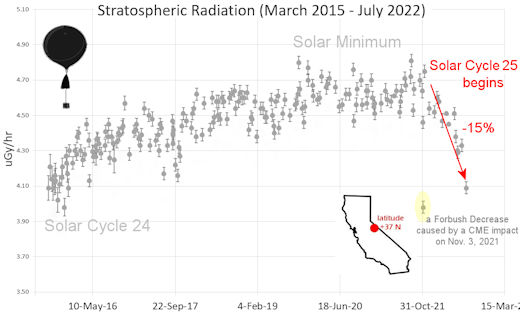
What's going on? Ironically, the radiation drop is caused by increasing solar activity. Solar Cycle 25 has roared to life faster than forecasters expected. The sun's strengthening and increasingly tangled magnetic field repels cosmic rays from deep space. In addition, solar coronal mass ejections (CMEs) sweep aside cosmic rays, causing sharp reductions called "Forbush Decreases." The two effects blend together to bring daily radiation levels down. .Who cares? Cosmic rays are a surprisingly "down to Earth" form of space weather. They can alter the chemistry of the atmosphere, trigger lightning, and penetrate commercial airplanes. According to a study from the Harvard T.H. Chan school of public health, crews of aircraft have higher rates of cancer than the general population. The researchers listed cosmic rays, irregular sleep habits, and chemical contaminants as leading risk factors. A number of controversial studies (#1, #2, #3, #4) go even further, linking cosmic rays with cardiac arrhythmias and sudden cardiac death. Technical notes: The radiation sensors onboard our helium balloons detect X-rays and gamma-rays in the energy range 10 keV to 20 MeV. These energies span the range of medical X-ray machines and airport security scanners. Data points in the graph labeled "Stratospheric Radiation" correspond to the peak of the Regener-Pfotzer maximum, which lies about 67,000 feet above central California. When cosmic rays crash into Earth's atmosphere, they produce a spray of secondary particles that is most intense at the entrance to the stratosphere. Physicists Eric Regener and Georg Pfotzer discovered the maximum using balloons in the 1930s and it is what we are measuring today. | | The official U.S. government space weather bureau | | | The first place to look for information about sundogs, pillars, rainbows and related phenomena. | | | Researchers call it a "Hubble for the sun." SDO is the most advanced solar observatory ever. | | | 3D views of the sun from NASA's Solar and Terrestrial Relations Observatory | | | Realtime and archival images of the Sun from SOHO. | | | information about sunspots based on the latest NOAA/USAF Active Region Summary | | | current counts of failed and deployed Starlink satellites from Jonathan's Space Page | | | Authoritative predictions of space junk and satellite re-entries | | | from the NOAA Space Environment Center | | | fun to read, but should be taken with a grain of salt! Forecasts looking ahead more than a few days are often wrong. | | | from the NOAA Space Environment Center | | | the underlying science of space weather |  | Getting YouTube comments is essential if you want to beat the algorithm! That’s why you need to buy YouTube comments from RealSocialz.com because they offer real USA comments you can customize. |  | BestCSGOGambling is the best site for everything related to CSGO gambling on the web |  | To find reviews of new online casino sites in the UK try The Casino DB where there are hundreds of online casino reviews complete with bonuses and ratings. Alternatively, Online-Casinos.xyz is another massive directory of online casinos listing sites for the UK and Worldwide. Casinos that offer Rupees for bonuses are very generous to Indian players. Find the best online casinos in India at AllCasinos.in Looking for a new online casino? Try Casimpo the new site dedicated to making online casino simple, or check out the new Avenger Slots Casino and Ace Online Casino with over 500 online slots and casino games. |  | When looking for casinos to play online when the weather is bad, you can try casino online trucchi for Italian games. If you are not from Finland you can try the Swedish page Svenska casino online to find suitable games, check out svenskacasinoonline.net. Always check your local laws before playing with real money. |  | Looking for sports betting companies not registered on GamStop? CasinoGap has presented a list of sites not on GamStop available for UK players. Check and bet online! Would you like to bet at sites not using GamStop? Look at a list of NonStopCasino sites for online betting that aren't on GamStop. Top-rated bookmakers ever! | | | These links help Spaceweather.com stay online. Thank you to our supporters! | | | | | | | | |  | |  |   | ©2021 Spaceweather.com. All rights reserved. This site is penned daily by Dr. Tony Phillips. | |

